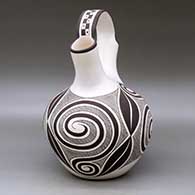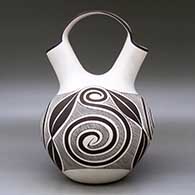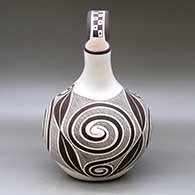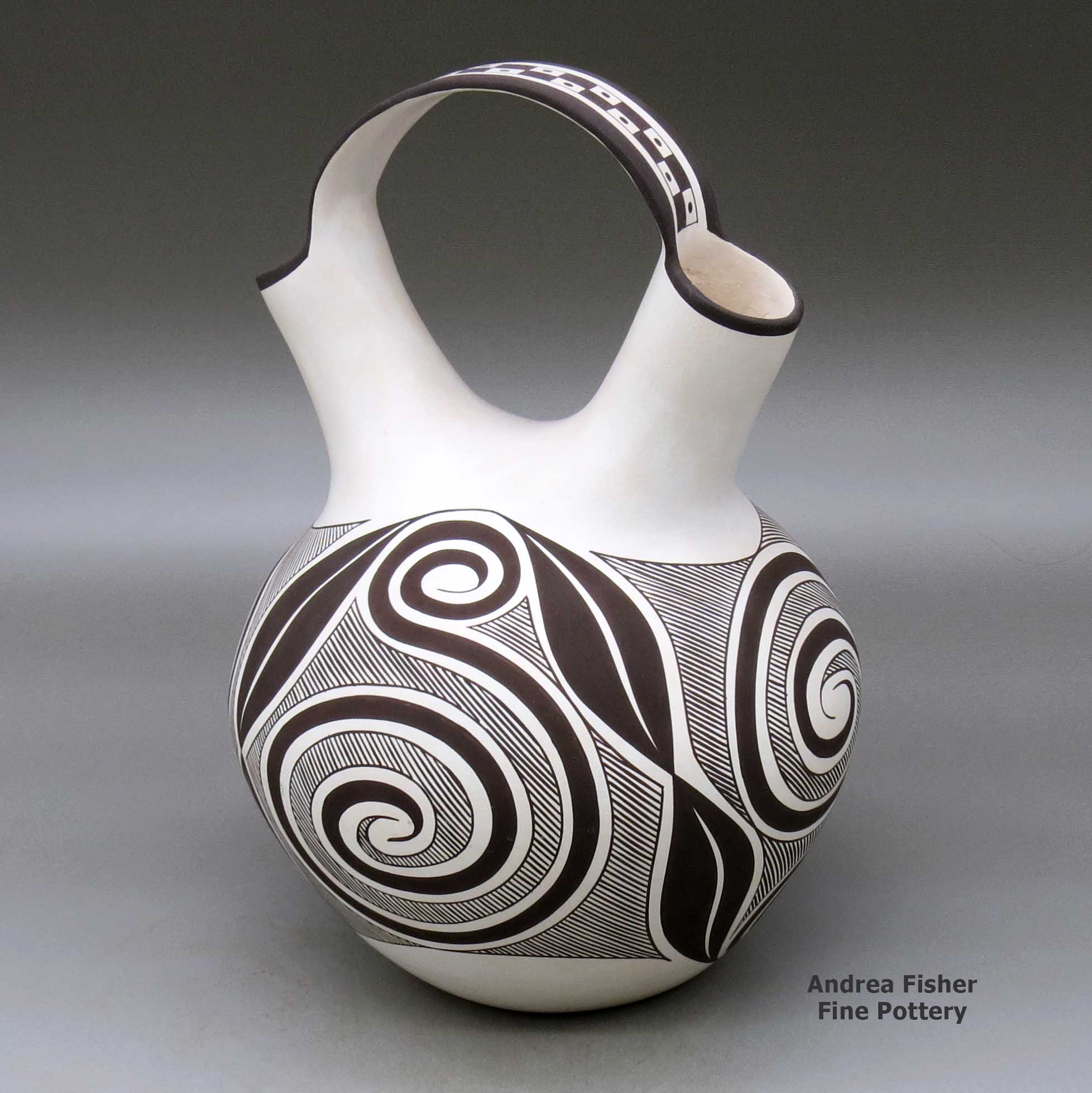
Click or tap to see a larger version
Myron Sarracino, Laguna, A black on white wedding vase decorated with a Tularosa spiral, fineline and geometric design
Laguna
$ 995
dkla5d118
A black on white wedding vase decorated with a Tularosa spiral, fineline and geometric design
8.75 in L by 9 in W by 12.75 in H
Condition: Very good
Signature: Myron Sarracino Laguna Pueblo
Tell me more! Buy this piece!
(505) 986-1234 - www.andreafisherpottery.com - All Rights Reserved
Myron Sarracino
Laguna
Born in January, 1967, to Joan and Mike Sarracino of Laguna Pueblo, Myron has become one of the top award-winning potters from Laguna Pueblo. He began learning the traditional methods of making pottery from Gladys Paquin while he was still a teen-ager. Gladys taught him to make thin-walled impeccable shapes and to paint exceptional designs. Working together they produced some of the finest polychrome pottery in the modern Laguna tradition.
Then in the 1990s Myron branched off from Gladys and he turned to creating pieces that harken back to the more ancient Mimbres and Tularosa shapes and designs. He's extensively studied those prehistoric designs and has developed some unique variations of some of them. The result: traditional hand-made pottery with an ancient look and contemporary refinements. His work is also well-known for his swirl designs, inspired by the migration trails of his ancestors.
Myron's collection of awards range from Honorable Mention to Best of Show from competitions at the New Mexico State Fair, Gallup Inter-Tribal Ceremonials and the Eight Northern Pueblos Arts and Crafts Show.
His favorite designs seem to be clouds, rain, Tularosa spirals, bighorn sheep, swirls, checkerboard, feathers-in-a-row and frets. He says he gets his inspiration from his grandparents, Thelma and Sandy Sarracino, and friends Gladys Paquin and Verna Soloman.
Laguna Pueblo
After the Pueblo Revolt of 1680, the pueblos were fearful of Spanish reprisals. Spanish militias returned several times in the 1680s, looting and burning before returning to safety south of El Paso. In those years, when the Puebloans became aware of approaching Spanish forces they mostly scattered into the mountains and the Spanish found empty pueblos, easy to loot and easy to burn. When Don Diego de Vargas marched north in 1692, he was intent on reconquering Nuevo Mexico and re-establishing a long-term Spanish presence there. As the conquistadors who accompanied him were on a "do-or-die" mission, the reconquest took on a tenor quite different from the previous missions...
At first de Vargas followed a path of reconciliation with the pueblos but that was soon replaced with an iron fist that brought on a second revolt in 1696. The pueblos didn't fare so well the second time around and a large number of Pueblo warriors were executed while their wives and children were forced into slavery. When word of de Vargas actions got back to the King of Spain, he ordered de Vargas banned from the New World. However, most of the damage was already done.
Many modern historians say Laguna Pueblo was established between 1697 and 1699 by refugees seeking to avoid the fighting with the Spanish. Many of those refugees had left the first pueblos approached by the Spanish in 1692. Most had scattered to more remote places like Acoma, Zuni and Hopi, or to more Spanish-friendly Isleta. However, the pressure of those refugees strained the resources of the other pueblos and quickly forced the refugees to consider starting a new existence in a newly-formed pueblo.
In the 1000s CE, groups of Keres-speaking people were migrating out of the Chaco Canyon area. Some went to the south around the west side of Mount Taylor (and eventually to Acoma), and some went around the east side. Those who went around the east side of the ancient volcano came to a large lake where they decided to settle. The number of abandoned pueblos in the area says they stayed close to that lake for many years, moving only as drought and exhausted soils forced them to. That lake is what caused the Spanish to name the village "Laguna" several hundred years later. Some of the land under Laguna control has also been found to contain archaeological resources dating as far back as 3,000 BCE.
On the east side of today's Laguna Reservation is where the Puerco River of the East flows. There were numerous pueblos established along the Puerco between about 1250 and 1450 CE. Among them was a village now named Pottery Mound, named for the massive mounds of potsherds in and around the ruin. Pottery Mound was abandoned before the Spanish first arrived but archaeologists have followed the tracks left by Pottery Mound styles, shapes and designs to Acoma, Zuni and to settlements in the Hopi mesas and the Four Corners area.
In the 1700s, several villages were established in the area around Old Laguna and when the Lagunas were granted their own reservation, they were given about 500,000 acres of land, making Laguna one of the largest of all pueblos in terms of land. However, only about half the enrolled members of the tribe live at Laguna as many have been drawn to nearby Albuquerque in search of work.
Laguna and Acoma share the same language (Western Keres), similar pottery styles and similar religious beliefs. However, pottery making almost died out at Laguna after the railroads arrived in New Mexico in 1880 and laid a primary east-west trackbed directly in front of the Laguna main pueblo. During that time period many Lagunas went to work on railroad construction crews and many of the traditional Laguna arts and crafts died out. It didn't help when a Methodist missionary was elected pueblo governor in 1872. Among his first steps in office was an order to destroy all the kivas on Laguna land. That caused a schism in the tribe and, shortly, about half the Lagunas left their reservation and relocated to Isleta. Many of them returned to Laguna years later but there are still some at Isleta.
Pottery making never completely stopped at Laguna but by 1960 it was almost gone. Then in 1973 and again in 1974 Nancy Winslow (an Anglo woman from Albuquerque) taught two four-month arts and crafts classes at the pueblo. Among the 22 pueblo members in the first class were Evelyn Cheromiah and her daughters. Rick Dillingham quoted Evelyn Cheromiah as saying that after "looking at my mother's pottery-making tools, I got the urge of going back to making pottery." That was the beginning of today's renaissance in Laguna pottery.
Because of their geographic proximity, Laguna and Acoma clays are very similar, although Laguna clay tends to be a bit more sandy. In some instances, it's very hard to determine if a particular pot is from Acoma or from Laguna. Laguna potters are more likely to temper their white clay with sand than with ground potsherds like the Acomas do. Laguna geometric designs also tend to be bolder than Acoma designs while Laguna potters use Mimbres designs much more sparingly than do Acoma potters.
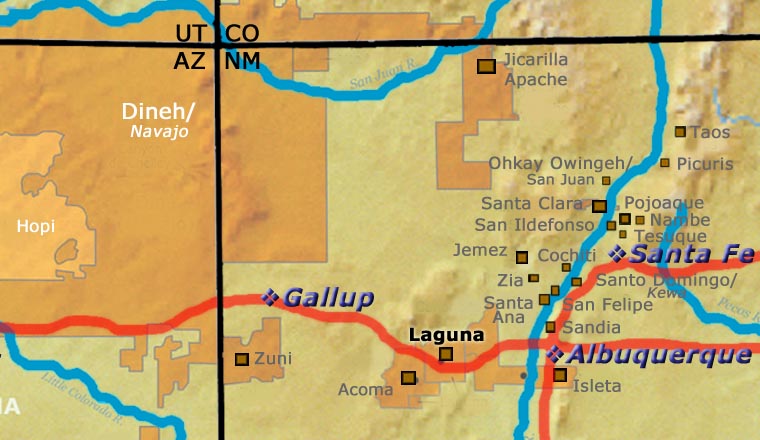
The Story of
the Wedding Vase
as told by Teresita Naranjo of Santa Clara Pueblo
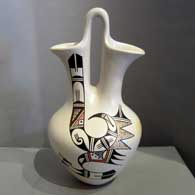
Helen Naha
Hopi

Wilma Baca Tosa
Jemez Pueblo

Margaret Tafoya
Santa Clara Pueblo
The Wedding Vase has been used for a long, long time in Indian Wedding Ceremonies.
After a period of courtship, when a boy and girl decide to get married, they cannot do so until certain customs have been observed. The boy must first call all his relatives together to tell them that he desires to be married to a certain girl. If the relatives agree, two or three of the oldest men are chosen to call on the parents of the girl. They pray according to Indian custom and the oldest man will tell the parents of the girl what their purpose is in visiting. The girl's parents never give a definite answer at this time, but just say that they will let the boy's family know their decision later.
About a week later, the girl calls a meeting of her relatives. The family then decides what answer should be given. If the answer is “no” that is the end of it. If the answer is “yes” then the oldest men in her family are delegated to go to the boy's home, and to give the answer, and to tell the boy on what day he can come to receive his bride-to-be. The boy must also notify all of his relatives on what day the girl will receive him, so that they will be able to have gifts for the girl.
Now the boy must find a Godmother and Godfather. The Godmother immediately starts making the wedding vase so that it will be finished by the time the girl is to be received. The Godmother also takes some of the stones which have been designated as holy and dips them into water, to make it holy water. It is with this holy water that the vase is filled on the day of the reception.
The reception day finally comes and the Godmother and Godfather lead the procession of the boy's relatives to the home of the girl. The groom is the last in line and must stand at the door of the bride's home until the gifts his relatives have brought have been opened and received by the bride.
The bride and groom now kneel in the middle of the room with the groom's relatives and the bride's parents praying all around them. The bride then gives her squash blossom necklace to the groom's oldest male relative, while the groom gives his necklace to the bride's oldest male relative. After each man has prayed, the groom's necklace is placed on the bride, and the bride's is likewise placed on the groom.
After the exchange of squash blossom necklaces and prayers, the Godmother places the wedding vase in front of the bride and groom. The bride drinks out of one side of the wedding vase and the groom drinks from the other. Then, the vase is passed to all in the room, with the women all drinking from the bride's side, and the men from the groom's.
After the ritual drinking of the holy water and the prayers, the bride's family feeds all the groom's relatives and a date is set for the church wedding. The wedding vase is now put aside until after the church wedding.
Once the church wedding ceremony has occurred, the wedding vase is filled with any drink the family may wish. Once again, all the family drinks in the traditional manner, with women drinking from one side, and men the other. Having served its ceremonial purpose, the wedding vase is given to the young newlyweds as a good luck piece.
Gladys Paquin Family Tree
Disclaimer: This "family tree" is a best effort on our part to determine who the potters are in this family and arrange them in a generational order. The general information available is questionable so we have tried to show each of these diagrams to living members of each family to get their input and approval, too. This diagram is subject to change should we get better info.
- Gladys Paquin Sratyu'we (1936-2020) and Andy Padilla Sr.
- Andrew Padilla Jr. (1956-2021)
- Max Early (1963-)
- Myron Saracino (1967-)
Some of the above info is drawn from Southern Pueblo Pottery, 2000 Artist Biographies, by Gregory Schaaf, © 2002, Center for Indigenous Arts & Studies
Other info is derived from personal contacts with family members and through interminable searches of the Internet and cross-examination of the data found.
Copyright © 1998-2025 by

